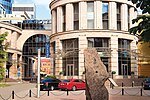Ligovsky Avenue
LigovoRussia road stubsSaint Petersburg geography stubsStreets in Saint Petersburg

Ligovsky Prospekt (Russian: Лиговский проспект) is a major street in Saint Petersburg. Before the establishment of the city, it was a street leading to Novgorod, used by the people living in the villages around the delta of Neva. During 1718 to 1725, when Saint Petersburg was the capital of Russia, construction began on the Ligovsky Canal. The canal was used to transfer water from the Liga River to fountains of the Summer Garden, hence the name of the street and the canal. After the flood of 1777 all the fountains were demolished, and later the canal was as well.
Excerpt from the Wikipedia article Ligovsky Avenue (License: CC BY-SA 3.0, Authors, Images).Ligovsky Avenue
Ligovskiy Avenue, Saint Petersburg
Geographical coordinates (GPS) Address Website Nearby Places Show on map
Geographical coordinates (GPS)
| Latitude | Longitude |
|---|---|
| N 59.9269 ° | E 30.3585 ° |
Address
Доктор Столетов
Ligovskiy Avenue
191136 Saint Petersburg (округ Лиговка-Ямская)
Saint Petersburg, Russia
Open on Google Maps











